- 02/20/2020
- Lou Roten
- First Edition of 2020
A Brief Study of the Impact on Auction Results of CAC Stickered Coins
I have been challenged by a few who still resist CAC coins. Here are a few reasons for that resistance:
- Some feel if a grading company grades a coin as an MS65, it must be an MS65 – what difference could a sticker make? Another expense.
- Some have seen stickered coins that they feel don’t deserve a sticker, and that CAC is not perfect. (Who is?)
- Technical grading is not always in line with eye appeal, and some varieties of toning may not be attractive to everyone.
- CAC coins are more expensive.
Most all our readers and clients understand the rationale for CAC. So, for you who do, please excuse the following observations:
Responding:
a) There are high end coins for the grade, there are low end coins for the grade; there are coins that barely make the grade; there are coins that are a whisker away from the next higher grade (GOLD CAC). There are coins that are overgraded. Of course, there are coins that do not deserve a grade at all. A CAC sticker helps sort through the difficulty most of us have deciding on a purchase. The expense is money well spent.
b) It does happen that there are CAC stickered coins that do not deserve a sticker; however, the vast majority of CAC stickers are deserved. One or two bad experiences should not cause one to abandon CAC. The vast majority of coins will never have a sticker.
c) Toning is interesting. Coins can be cleaned and toned back; this characteristic should be seen quickly by an experienced grader. Sometimes a coin will still sneak by. Some toning is simply unattractive to some, but is an indication of an original surface; the CAC sticker is intended to indicate a technically correct graded coin.
d) They are more expensive; but the CAC sticker is a very positive factor when it comes to selling your coins. I would expect that the price gap between CAC coins and non-CAC coins would widen with time; the data follows. (I included both PCGS and NGC auction results).
I have chosen a few coins at random, but popular coins, to see the impact of CAC stickers on auction results for those coins. I did not know ahead of time what the results would show, except to say I did expect there should be some auction price advantage for CAC coins. This was an exercise for me see the big picture, apart from a few isolated instances of disagreement, on the merit of a CAC sticker on a few particular coins. I did anticipate that there probably would be a difference in price for CAC coins because RCNH has experienced some very dramatic results when submitting client’s coins purchased from RCNH decades ago, before CAC existed (CAC began in late 2007). I note here that RCNH may be unique in the industry. When buying our client’s coins, we will, before making an offer, first submit coins to CAC (or, in some cases, first submit for upgrades) so the client benefits. We know of dealers who buy coins from trusting collectors, then submit them to CAC for their own benefit. We feel strongly that the latter practice is not the proper treatment of a client’s interests.
The first example is the relatively common 1910-D $10 Indian Gold Eagle
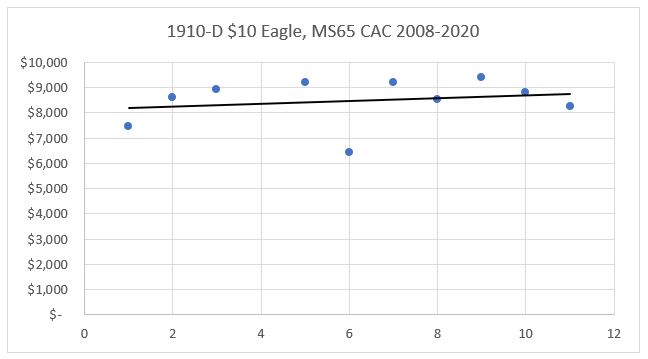
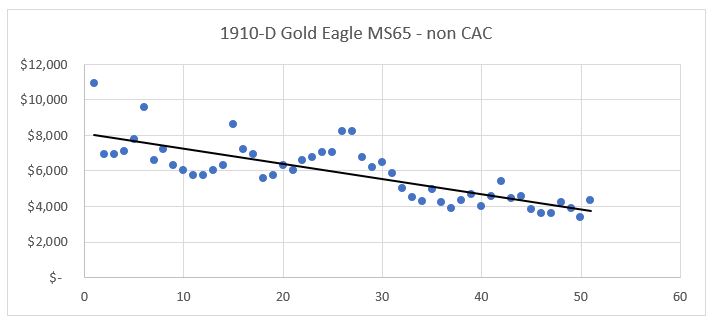
The 1st graph above shows auction results for a 1910-D $10 Eagle in MS65 with a CAC sticker. An average price is about $8500.00, but is gradually increasing. One GOLD stickered example sold for almost $18,000. The 2nd graph has the auction results for non CAC examples. The prices were erratic early and have since fallen to around $4000 from the earlier high around $8000. The horizontal axes in both cases represent the number of coins graded with time moving left to right (2008 to 2020); I was able to find only 11 MS 65 CAC examples in the period 2008 – 2020 (I removed the GOLD stickered coin). Now, a green CAC stickered MS65 sells for more than double a non stickered MS65, and the gap is widening.
The second example is a 1927-S Walking Liberty Half Dollar
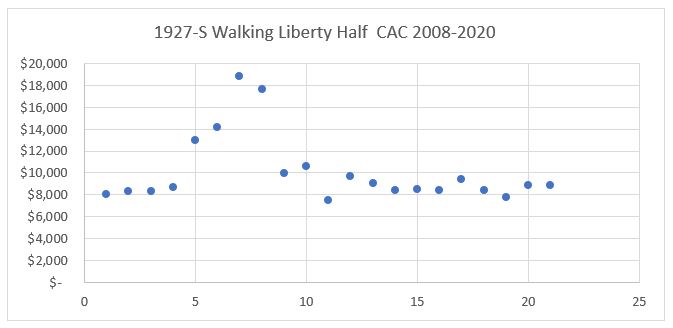
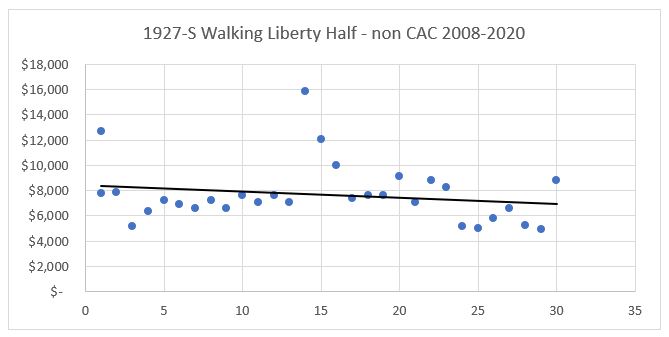
The 1st of the two graphs above shows auction results for MS65 CAC stickered examples. An average price is about $9000.00. The high outliers have a major affect a trend line, so I have removed it; I could have eliminated them (i.e. the outliers), but the data does show a relatively consistent pricing with a slightly upward trend from $8000 to $9000. The highs may have been results of aggressively competetive bidding. The 2nd graph has the auction results for non CAC examples. Again there are some high outliers which raise the trand line, but the trend of the rest is a gradual decrease from about $7000 to around $6000. The horizontal axes in both cases again represent the number of coins graded with time moving left to right; I was able to find only 21 MS 65 CAC examples in the period 2008 - 2020. A green CAC stickered MS65 now sells for about 50% ($9000 to $6000) more than a non stickered MS65. Again the gap is widening.
The third example is a 1930-S MS65 FH Standing Liberty Quarter
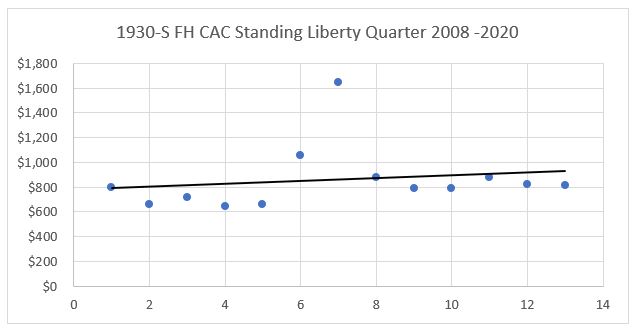
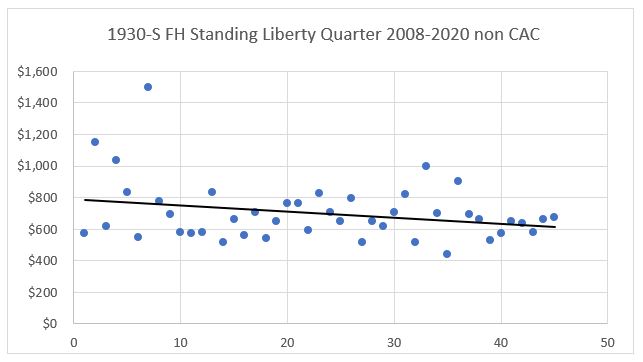
The 1st of the two graphs above shows auction results for MS65 CAC stickered examples. The pricing trend shows a gradual increase from about $750 to $825. The high outliers do affect the trend line. The 2nd graph has the auction results for non CAC examples. Again there are some early high outliers, but the trend shows a gradual decrease from around $800 to $600. The horizontal axes in both cases represent the number of coins graded with time moving left to right; I was able to find only 13 MS 65 CAC examples in the period 2008 - 2020. A green CAC stickered MS65 sells for about 40% ($825 to $600) more than a non stickered MS65.
The fourth and last example is a 1934-D MS65 Peace Dollar


The 1st of the two graphs above shows auction results for MS65 CAC stickered examples. The trend line shows a gradual decline from about $1600 to about $1400 (the trend line is high because of the high outliers) . The high outliers are old green PCGS holders. The 2nd graph has the auction results for non CAC examples. It shows a gradual decline from about $1400 to $850. There are a few inexplicable high outliers(note: I did not include auctions for the DDO 1934-D). The horizontal axes in both cases again represent the number of coins graded with time moving left to right; I was able to find only 27 MS 65 CAC examples in the period 2009 - 2020. A green CAC stickered MS65 now sells on average for about 65% ($1400 to $850) more than a non stickered MS65. 11 years ago the increment was only about 23% ($1600 to $1300).
In sum, it is apparent that CAC stickers have affected the auction results for these 4 coins. It should be the case that better coins are scarcer and worth more. It is not a stretch to think that for the key dates and for gem examples of most coins, the results will be much the same. Next time, I will look at a few other coins.
Lou Roten - adjunct instructor retired - mathematics / physics, Franklin Pierce University; environmental scientist; fiddler; life-long interest in collecting coins and stamps with some interruptions; very interested in the evolution of the coin making process.